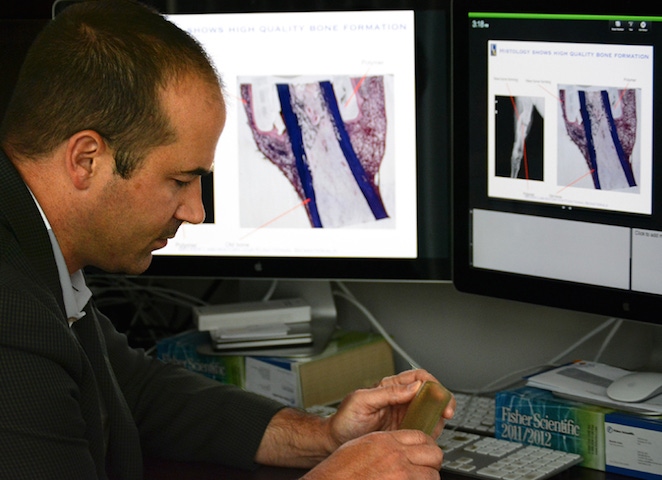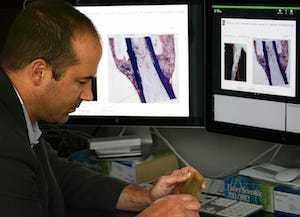Polymer device could reduce number of battlefield-caused amputations
A polymer-based medical device has been developed that could promote new bone growth and, thus, prevent amputations among soldiers wounded by gunshots and improvised explosive devices (IEDs). Mattew Becker, a professor of polymer science at the University of Akron (UA; Akron, OH), led the research, which involves using a cylinder-shaped polymeric shell to stabilize the site of injury while the missing bone regenerates. The team of scientists from the University of Akron, Houston Methodist Research Institute and Texas A&M University received a $6 million grant from the U.S.
October 7, 2015

A polymer-based medical device has been developed that could promote new bone growth and, thus, prevent amputations among soldiers wounded by gunshots and improvised explosive devices (IEDs). Mattew Becker, a professor of polymer science at the University of Akron (UA; Akron, OH), led the research, which involves using a cylinder-shaped polymeric shell to stabilize the site of injury while the missing bone regenerates. The team of scientists from the University of Akron, Houston Methodist Research Institute and Texas A&M University received a $6 million grant from the U.S. Army Medical Research and Materials Command to fund their work in this limb-salvage technique.
|
Polymer science professor Matthew Becker examines |
A two-year pilot study has shown unprecedented results in bone regeneration, writes Denise Henry on the UA website. "Their investigation involved the use of a biodegradable polymer scaffold that bridges the injured bone site, stabilizes the area of missing bone and stimulates bone regrowth in it. The shell is filled with decellularized collagen developed at Houston Methodist Research Institute," explains Henry. The fractured ends of a broken bone are inserted into opposite sides of the tube-shaped scaffold, where new bone forms, Becker explained to Henry.
The scaffold, or shell, has an osteoconductive effect that generates new bone growth, stabilizes the injury site quickly, and induces limb healing and function. Becker considers the technology to have great potential beyond the battlefield, as well, noting that it "would have been a game-changer in civilian accidents like the Boston Marathon bombing."
Initial materials reportedly will be ready for military trials in wounded soldiers by next spring.
"This could be a transformative advance," said Becker in the article, noting that the device and procedure have the potential to spare injured military members with enough remaining bone and soft tissue from limb amputation.
Becker's team developed the polymer-based scaffold while researchers at Houston Methodist Research Institute conducted preclinical trials. Texas A&M scientists studied the biomechanics of the newly developed limbs in these studies. The polymer synthesis will be scaled up with the assistance of materials company Akron Polymer Systems (Akron, OH) and the finished shells for use in humans will be molded by Cook Biotech (West Layfaette, IN), a medical technology company specialized in regenerative medicine.
About the Author(s)
You May Also Like



